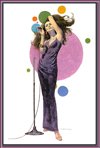Here is a tribute to Suzy Parker, the willowy, red-headed beauty whose elegant poses on scores of magazine covers defined glamour in the 1950s and paved the way for the supermodels to follow.
In the period just after World War II, models were becoming celebrities. Fashion's influence was inexorably expanding from high society to society at large, and Suzy Parker, along with other models, signified a postwar world of stylish promise for all. When Miss Parker posed in one of fashion's first bikini shots, America noticed.
Miss Parker was the first model to make more than $100 an hour and $100 000 a year, said Eileen Ford, the doyenne of modeling agents. She also worked as a professional photographer and editor, and she appeared in lead roles in movies with Cary Grant and Gary Cooper.
Ms. Ford said she was simply staggered when the famed model Dorian Leigh, Miss Parker's oldest sister, introduced her to Suzy, then 15.
“She was the most beautiful creature you can imagine,” Ms. Ford said. “She was everybody's everything.”
Miss Parker's trademark in photographs and later on the movie screen was icy sophistication, often likened to that of Grace Kelly, but in person she exuded a girl-next-door prettiness and a sort of wacky loquaciousness. Audrey Hepburn's role in Funny face, as a fast-talking beatnik who somewhat unwillingly becomes a world-famous model, was inspired by her, and she made a cameo appearance in the film, her first movie role.
Miss Parker adored slouch hats of the sort favored by Garbo and collected Coco Chanel's classic designs for herself. Richard Avedon, the photographer, called her “my most challenging and complicated of muses.”
Cecilia Ann Renee Parker was born in San Antonio on Oct. 28, 1933. While still in high school in Jacksonville, Fla., she modeled in the summers for Ford Models, and after graduation went to work full-time for the agency. In a silent profession Miss Parker was outspoken.
“Suzy Parker didn't stop talking when I first tried to take her picture,” Horst, the photographer, said. “I said, 'You keep talking,' and I left. When she got into the movies, I joked that maybe she would do for the movies what she would never do for me – hold still.”
She publicly condemned drinking and smoking and said marriage killed romance. The New York Daily News reported her lecturing a French economist about the French economy. She said she talked too much for most men.
Her often-quoted remark that she could love a man more when she was not married to him exploded in headlines when it turned out she was secretly married.
That marriage, to Pierre de la Salle in 1958, was actually her second; she had been briefly married to a high-school sweetheart. She and Mr. de la Salle, from whom she was later divorced, had a daughter, Georgia, of Paris, who survives her.
In 1963 she married Mr. Dillman, who survives her, along with their daughter, their sons, and four grandchildren.
Her sisters Dorian Leigh of Paris and Florian Boice of Annapolis, Md., also survive her.
Miss Parker said she looked in the mirror each day and thanked God for her cheekbones. But she insisted that she modeled only for money and had other professional ambitions. In the mid-1950s she temporarily abandoned being a cover girl for several years to be a photographer herself, apprenticing with Henri Cartier-Bresson in Paris and working for the French edition of Vogue.
It was through Mr. Avedon that Miss Parker parlayed her modeling fame into a movie career. As visual consultant in the movie Funny face, Mr. Avedon selected her for a brief but conspicuous appearance. Written by Leonard Gershe and directed by Stanley Donen, the 1957 film depicted a high-fashion photographer not unlike Mr. Avedon, played by Fred Astaire. Miss Parker was the inspiration for Audrey Hepburn's character in the film, a somewhat kooky intellectual and free spirit.
Hepburn, in turn, became such a cheerleader that Miss Parker called the actress her “Hollywood press agent.”
Miss Parker was cast opposite Cary Grant in Kiss them for me in 1957. She appeared with Gary Cooper the next year in Ten North Frederick.
She appeared in 1959 in The best of everything. In 1961 she played opposite Mr. Dillman in A circle of deception. They wed in 1963.
Miss Parker was in several more movies and became a sought-after television guest in the 1960s. Her most famous television appearance was in a 1963 episode of Twilight zone in which she played six different parts.
She retired from acting in the mid-1960s and moved with Mr. Dillman to the Santa Barbara area.
In his book Cover girls and supermodels, 1945-1965 (published in 1996), the French journalist Jean-Noël Liaut said Miss Parker had escaped the unhappy outcomes of other stellar models.
He wrote, “She became a perfect housewife, even to the extent of baking her own bread.”
She passed away in 2003.
Enjoy Suzy Parker’s grace!









Aucun commentaire:
Enregistrer un commentaire